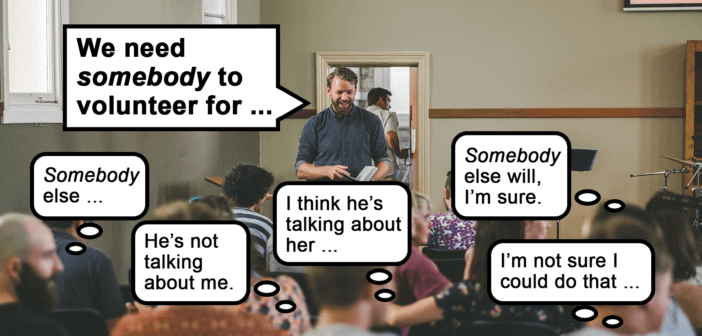Lewis Center Director Doug Powe explains why recruitment efforts based on general appeals invariably fall flat. It’s far more effective to generate interest through firsthand testimonies and personal invitations to individuals or groups.
We have all heard it and even done it. We stand up in front of the church and say, “We need somebody to volunteer for our mission project on Saturday.” We just know that after church, folk will start coming to us to sign up. But all too often, we are shocked when no one volunteers. For the life of us, we cannot figure out what we did wrong. We clearly explained the mission project. We clearly explained the time commitment. The problem is that we asked for the mythical parishioner named “somebody” to sign up.
The problem with somebody
When giving a general announcement it is common to ask for somebody. But the unintended consequence of using this language is everyone thinks you are talking to someone else. When we hear somebody, we often believe the announcement isn’t for us. Such a general plea typically misses the mark because no one hearing it pictures themselves as somebody.
What’s a more effective approach? These three ideas can help connect volunteers to ministry opportunities.
1. Present firsthand testimony.
When seeking volunteers, instead of making a vague appeal for somebody, have an individual already involved in the project share their experiences. They might share how they have been personally transformed by the work, the impact of the work on other volunteers, or the opportunity the work provides to make new friends and connect more deeply with individuals they would otherwise only see on Sundays. Such firsthand accounts can be inspiring and help others see what is possible.
In some congregations, this firsthand testimony takes the form of a “mission moment” — two to three minutes where a current ministry participant shares their experience and invites further conversation during fellowship time. This opens the door to more personal ways of engaging those whose interest is piqued. The mission moment also educates the congregation about how the church is at work in the world.
2. Invite classes and small groups to participate.
Instead of making a general announcement for somebody, consider inviting a Sunday school class or Bible study group to participate in the ministry opportunity as a team. Such close-knit groups might appreciate the opportunity to serve together. It may be that the class participates in a ministry opportunity on Saturday and then reflects on the experience as part of their weekly lesson on Sunday. Another possibility is having a group participate in a ministry project as a culminating event at the end of their study.
And don’t just think about adult classes. Inviting adult and youth classes to serve together is a great way to facilitate more intergenerational connections. It may encourage youth (and adults also) to invite a friend from beyond the congregation to join the effort. There’s a greater likelihood of success if a class owns the responsibility of securing participation than if you make a general announcement for somebody.
3. Extend personal invitations.
The best way to get people involved is not to stand up and ask for somebody or anybody, but to extend personal invitations. You can still make a general announcement as a way of planting the seed. But then follow up with personal invitations.
Personal invitations, by their very nature, are more effective than general ones. When we are invited personally to take on a job, it signals that the person making the invitation thinks we are capable and the job is a good fit for our gifts and talents. It is, in a sense, flattering as it builds the esteem of the person being invited. It is also true that we can’t easily ignore an ask when it comes in the form of a personal invitation. The goal isn’t to put others on the spot but to let them know you genuinely believe their presence will make a difference.
The next time you’re recruiting volunteers, don’t call for the infamous somebody or anybody. Instead, try offering firsthand testimony, inviting groups or classes to take on the responsibility, and extending personal invitations. Getting volunteers can be challenging, but moving away from general pleas can help improve the results.
Related Resources
- Increasing Active Engagement Video Tool Kit
- 10 Ways to Master the Art of Asking by Ann A. Michel
- 50 Ways to Increase Active Engagement, a free resource from the Lewis Center







